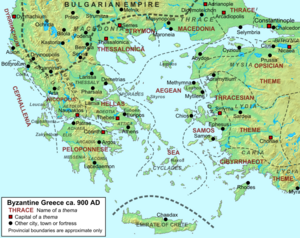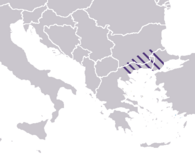Macedonia (theme) facts for kids
Quick facts for kids Theme of Macedonia
Μακεδονία, θέμα Μακεδονίας
|
|
|---|---|
| Theme of the Byzantine Empire | |
| 790s/802 – 11th century | |
 Map of Byzantine Greece c. 900, with the themes and major settlements. |
|
| Capital | Adrianople |
| Historical era | Middle Ages |
|
• Established
|
789/797 – 801/802 |
|
• Merged with Thrace.
|
Various times in late 10th and early 11th centuries |
| Today part of | Turkey Bulgaria Greece |
The Theme of Macedonia (Greek: θέμα Μακεδονίας) was a special kind of province in the Byzantine Empire. It was like a military and civilian district. It was created between the late 700s and early 800s. This region, called Byzantine Macedonia, was not in the same place as the Ancient Macedonia you might know from history. It was mostly in what is now Southern Thrace. Its main city and capital was Adrianople.
Contents
A Look Back: History of the Theme
Early Challenges and Changes
For a long time, starting in the 500s, the area that became the Theme of Macedonia faced many attacks. These attacks came from groups called Slavic tribes. Over the next few centuries, these attacks changed the people and culture of the region a lot.
The Slavs formed their own groups called "Sklaviniai". They kept attacking the Byzantine Empire. Sometimes they attacked alone, and sometimes they had help from groups like the Bulgars or Avars.
In the late 600s, the Byzantines launched a huge military trip against the Slavs. They managed to control many Slavic tribes. They also set up a new "theme" (a military district) called theme of Thrace. This new theme was located inland from the city of Thessaloniki.
Even with these successes, the Byzantines didn't have full control. The Empire decided to move its defense line south, closer to the Aegean Sea coast. This continued until the late 700s.
Creating the Theme of Macedonia
Because of these changes, a new theme called Macedonia was created. This happened between 789 (or 797) and 801/802. It was formed by Empress Irene of Athens from parts of the older theme of Thrace.
Records show that a military division called "Macedonia" existed before this. It was part of the Thrace theme. The first known leader of Macedonia, called a strategos, was John Aplakes in 813. However, some historians say that a general named Leo was in charge of both Thrace and Macedonia earlier, around 801/802.
This new theme was created after the Byzantines had won several battles. These wins helped them control more land in the wider Thrace region. Creating two themes instead of one probably helped the Empire manage this larger area better.
Later Years and Changes
The Theme of Macedonia was still active in the 960s. But it wasn't listed in a document from around 975. This made some people think it might have been removed and combined with the command of a new leader in Adrianople.
However, the Theme of Macedonia was mentioned again in 1006/7. There is also evidence that it continued to exist alongside the Adrianople district.
In the late 900s, the theme stopped being a border area. This was because of new lands conquered by emperors John I Tzimiskes (who ruled from 969–976) and Basil II (who ruled from 976–1025). New provinces were created to its north, around cities like Philippopolis and Beroe. A new theme called Boleron was also created to its south in the early 1000s.
Not much is known about how the province was organized in the 1100s. In a special document given to the Venetians in 1198, "Thrace and Macedonia" were described as one large area. But this area was divided into smaller parts, each centered on a major city. The main part of the old Theme of Macedonia was then known as the "province of Adrianople and Didymoteichon".
Where It Was: Geography and Administration
Location and Capital
The main city of the new theme was Adrianople (which is modern Edirne in Turkey). The theme included parts of what is now Western Thrace (in Greece), the western parts of Eastern Thrace (in European Turkey), and the southern edges of Northern Thrace (in southern Bulgaria).
Arab geographers from the 800s and 900s wrote about the Byzantine themes. They said that the Theme of Macedonia stretched from the "Long Wall" (the Anastasian Wall) to the "lands of the Slavs" in the west. It also went from the Aegean and Marmara Seas to the borders of Bulgaria in the north.
Later, to its west, it bordered the theme of Thessalonica. It also bordered the later themes of Strymon and Boleron.
Not the Ancient Macedonia
It's important to know that the Theme of Macedonia had no connection to the historical region of Macedonia. When Byzantine writers from the 900s to 1100s talked about "Macedonia," they meant this area in western Thrace. For example, Emperor Basil I "the Macedonian" (who ruled from 867–886) was from Thrace. The Macedonian dynasty he started was named after the Theme of Macedonia, not the ancient region.
Military and Leadership
Because it was created from the Theme of Thrace, Macedonia was considered one of the "Eastern" themes. These themes were ranked higher in the Byzantine system than the "Western" themes.
In the late 800s and 900s, the strategos (military governor) of Macedonia was very important. He was ranked higher than even the strategos of Thrace. He received a large yearly salary of 36 pounds of gold. That's about 2,592 gold coins! According to one Arab writer, the strategos of Macedonia commanded 5,000 soldiers in the late 800s.
Some special military units, called tagmatic soldiers, were also always stationed in the theme. The region of Strymon was originally a smaller part of Macedonia. It separated sometime in the early 800s. When it split, it took about 2,000 soldiers with it.
Like other themes, some of the administrative jobs in Macedonia were sometimes combined with those of Thrace. This happened especially in the 1100s. Many strategoi and judges (kritai) were in charge of both themes at the same time.


